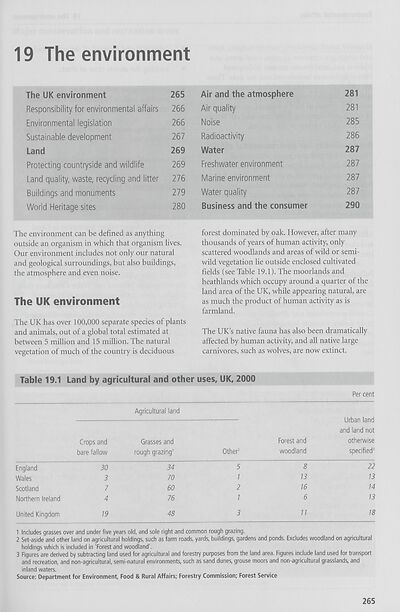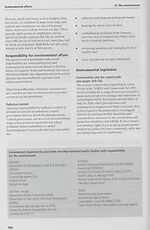Download files
Complete book:
Individual page:
Thumbnail gallery: Grid view | List view

19 The environment
The UK environment 265
Responsibility for environmental affairs 266
Environmental legislation 266
Sustainable development 267
Land 269
Protecting countryside and wildlife 269
Land quality, waste, recycling and litter 276
Buildings and monuments 279
World Heritage sites 280
Air and the atmosphere 281
Air quality 281
Noise 285
Radioactivity 286
Water 287
Freshwater environment 287
Marine environment 287
Water quality 287
Business and the consumer 290
The environment can be defined as anything
outside an organism in which that organism lives.
Our environment includes not only our natural
and geological surroundings, but also buildings,
the atmosphere and even noise.
The UK environment
The UK has over 100,000 separate species of plants
and animals, out of a global total estimated at
between 5 million and 15 million. The natural
vegetation of much of the country is deciduous
forest dominated by oak. However, after many
thousands of years of human activity, only
scattered woodlands and areas of wild or semi¬
wild vegetation lie outside enclosed cultivated
fields (see Table 19.1). The moorlands and
heathlands which occupy around a quarter of the
land area of the UK, while appearing natural, are
as much the product of human activity as is
farmland.
The UK’s native fauna has also been dramatically
affected by human activity, and all native large
carnivores, such as wolves, are now extinct.
Table 19.1 Land by agricultural and other uses, UK, 2000
Per cent
Other1 2
Forest and
woodland
Urban land
and land not
otherwise
specified3
8
13
16
6
22
13
14
13
18
Agricultural land
Crops and
bare fallow
England
Wales
Scotland
Northern Ireland
30
3
7
4
Grasses and
rough grazing'
34
70
60
76
United Kingdom
19
48
1 Includes grasses over and under five years old, and sole right and common rough grazing.
2 Set-aside and other land on agricultural holdings, such as farm roads, yards, buildings, gardens and ponds. Excludes woodland on agricultural
holdings which is included in 'Forest and woodland'.
3 Figures are derived by subtracting land used for agricultural and forestry purposes from the land area. Figures include land used for transport
and recreation, and non-agricultural, semi-natural environments, such as sand dunes, grouse moors and non-agricultural grasslands, and
inland waters.
Source: Department for Environment, Food & Rural Affairs; Forestry Commission; Forest Service
265
The UK environment 265
Responsibility for environmental affairs 266
Environmental legislation 266
Sustainable development 267
Land 269
Protecting countryside and wildlife 269
Land quality, waste, recycling and litter 276
Buildings and monuments 279
World Heritage sites 280
Air and the atmosphere 281
Air quality 281
Noise 285
Radioactivity 286
Water 287
Freshwater environment 287
Marine environment 287
Water quality 287
Business and the consumer 290
The environment can be defined as anything
outside an organism in which that organism lives.
Our environment includes not only our natural
and geological surroundings, but also buildings,
the atmosphere and even noise.
The UK environment
The UK has over 100,000 separate species of plants
and animals, out of a global total estimated at
between 5 million and 15 million. The natural
vegetation of much of the country is deciduous
forest dominated by oak. However, after many
thousands of years of human activity, only
scattered woodlands and areas of wild or semi¬
wild vegetation lie outside enclosed cultivated
fields (see Table 19.1). The moorlands and
heathlands which occupy around a quarter of the
land area of the UK, while appearing natural, are
as much the product of human activity as is
farmland.
The UK’s native fauna has also been dramatically
affected by human activity, and all native large
carnivores, such as wolves, are now extinct.
Table 19.1 Land by agricultural and other uses, UK, 2000
Per cent
Other1 2
Forest and
woodland
Urban land
and land not
otherwise
specified3
8
13
16
6
22
13
14
13
18
Agricultural land
Crops and
bare fallow
England
Wales
Scotland
Northern Ireland
30
3
7
4
Grasses and
rough grazing'
34
70
60
76
United Kingdom
19
48
1 Includes grasses over and under five years old, and sole right and common rough grazing.
2 Set-aside and other land on agricultural holdings, such as farm roads, yards, buildings, gardens and ponds. Excludes woodland on agricultural
holdings which is included in 'Forest and woodland'.
3 Figures are derived by subtracting land used for agricultural and forestry purposes from the land area. Figures include land used for transport
and recreation, and non-agricultural, semi-natural environments, such as sand dunes, grouse moors and non-agricultural grasslands, and
inland waters.
Source: Department for Environment, Food & Rural Affairs; Forestry Commission; Forest Service
265
Set display mode to:
![]() Universal Viewer |
Universal Viewer | ![]() Mirador |
Large image | Transcription
Mirador |
Large image | Transcription
The item on this page appears courtesy of Office for National Statistics and may be re-used under the Open Government Licence for Public Sector Information.
| Britain and UK handbooks > UK: The official yearbook of the United Kingdom of Great Britain and Northern Ireland > 2003 > (295) |
|---|
| Permanent URL | https://digital.nls.uk/204926945 |
|---|
| Attribution and copyright: |
|
|---|---|
| Description | Three volumes of 'UK: The official yearbook of the United Kingdom of Great Britain and Northern Ireland', published annually by the Office of National Statistics from 2002-2005. |
|---|---|
| Shelfmark | GII.11 SER |
| Description | Three titles produced by the British Government from 1954-2005 describing 'how Britain worked'. They are: 'Britain: An official handbook' (1954-1998), 'Britain: The official yearbook of the United Kingdom' (1999-2001), and 'UK: The official yearbook of the United Kingdom of Great Britain and Northern Ireland' (2002-2005). These 50 reports provide an overview of Britain's economic, social and cultural affairs, its environment, international relations, and the systems of government. They give an impartial summary of government policies and initiatives, and explain how public services are organised. |
|---|---|
| Additional NLS resources: |
|

